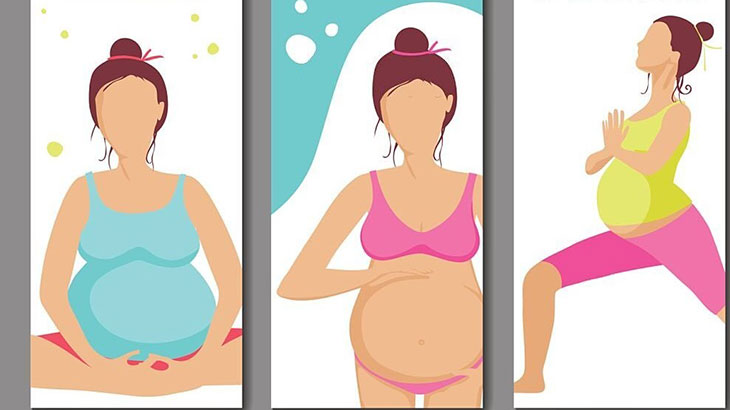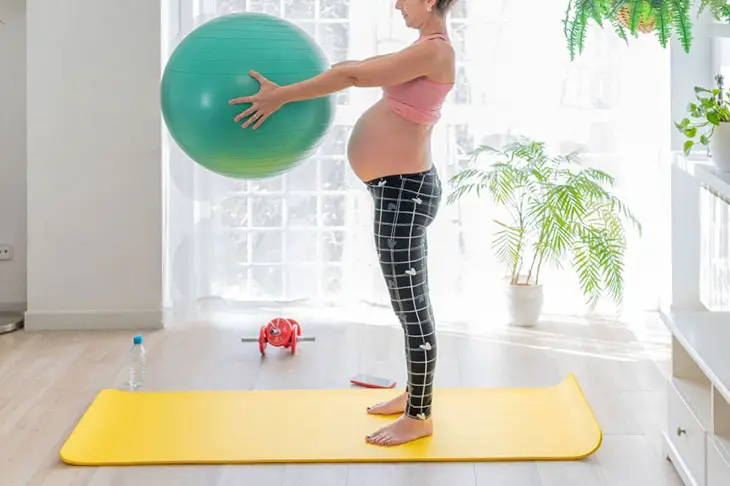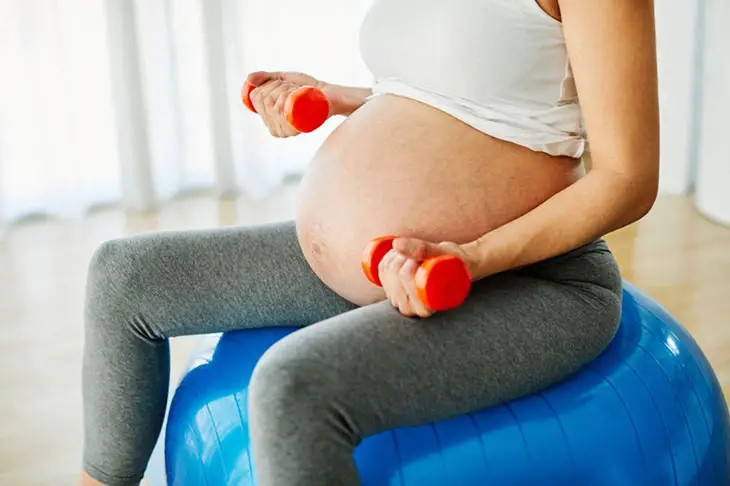While there’s no guarantee that any natural method will work, some exercises may help your body prepare for labor and encourage your baby to move into a favorable position.
Also, staying active can help you cope with discomfort, stress, and boredom while waiting for the big day.
In this article, I’ll share some of the best exercises to induce labor naturally and also explain when it’s safe to try them, who should avoid them, and how to do pregnancy exercises to induce labor correctly.
Why Should You Have Exercises To Induce Labor?

You’ve been waiting nine months to meet your baby, and the due date is approaching. You’re excited, nervous, and maybe a little impatient.
You wonder if there’s anything you can do to speed up the process and make labor easier. The answer is yes: exercises to induce labor.
Regular exercises to induce labor are safe and natural ways to help your body and baby prepare for birth. They have many benefits, such as:
- Stimulates the production of oxytocin and hormone that triggers contractions.
- Improve blood circulation and reduce swelling and discomfort.
- Strengthen your muscles, especially your pelvic floor
- Relax your mind and body, and increase your confidence and endurance
You can do exercises to induce labor at home, at work, or anywhere you feel comfortable. You don’t need special equipment or skills, just a positive attitude and a willingness to try.
When Should You Apply Pregnancy Exercises To Induce Labor?
You’re ready to meet your baby (and to end your pregnancy), but you shouldn’t have stretches to induce labor too soon.
The American College of Obstetricians and Gynecologists (ACOG) says a baby is safest when born between 39 and 41 weeks.
But if you’ve reached 39 weeks—or beyond—you may want to ask your doctor or health care provider about the right time for labor and the safest exercises to follow.
It is really good for your birthing process.
8 Labor Exercises To Induce Labor

If you have delivery plans through simple exercises, consider choosing the best exercise to induce labor suggested by our guide.
All of them are supported as low-impact exercises; therefore, you can do them yourself or with your husband.
Only by following the right steps can you completely remove feelings from the pregnancy complication process.
Engaged Breathing
Most people breathe out with their abdominals. But if you want this exercise to start labor, you must breathe in with your core and diaphragm.
How does a breathing exercise routine during pregnancy work?
You fist inhale through your nose and squeeze your baby with your belly muscles. Remember to hold your breath for a second, then exhale slowly through your mouth.
If you get a strong relaxation and some signs of your baby moving down, it is wondering for your body.
You can try this breathing on a ball, on your knees, or in a squat position. It is highly recommended as one of the simple ways to have a cervix for delivery better.
Try it for good experiences!
Supported Forward Bend
The supported forward bend is one of the exercises without causing serious pain during labor.
This pose stretches your lower back, hips, and hamstrings and can relieve tension and discomfort.
To do this exercise, you must stand with your feet hip-width apart and place a chair or a table in front of you.
Remember to lean forward and rest your arms on the support, keeping your back straight.
You must maintain deep breaths and relax your shoulders and neck. When you feel comfortable, you can hold these core muscle relaxation practices for a few minutes.
Sit With A Butterfly Pose
This simple stretch can help open up your hips and pelvis, making more room for your baby to descend.
It can also improve blood circulation and ease lower back pain. Let’s begin these labor positions in 5 steps, including:
- Sit on the floor with your back straight and keep your legs bent at your knees
- Bring your feet ‘ soles together and comfortably move your knees to the sides.
- Hold your ankles or feet and gently press your knees with your elbows.
- Hold the pose and focus on breathing deeply for 10 – 15 seconds.
- Repeat this pose several times/per day.
You can do this body transition together in sleeping positions to induce labor to promote the active labor process effectively.
Remember to always prioritize your comfort and stop immediately if you are feeling bad.
Have Squats
Deep squats are one great range of motion to increase the rate of labor induction. They work your glutes and legs, open your pelvis and nudge the baby down.
You can follow some steps to have the proper position with squats.
- Find a wall and an exercise ball (optional).
- Stand with feet apart, toes out.
- Breathe out and squat low, keeping your knees out.
- Breathe in and rise slowly and enjoy the stretch.
Apply Slow Dance
Slow dancing is a romantic and relaxing way to induce labor. It helps you bond with your partner, release oxytocin, and open your pelvis.
All you need is some soft music and a cozy space.
You must wrap your arms around your partner and sway gently. You can also do some pelvic tilts and circles.
If you sometimes keep slow dancing, it can help ease your stress and pain and better encourage your premature labor.
Exercise Ball Bounce
A birthing ball is a large inflatable ball that can help you prepare for labor in various ways, practice different positions, relieve pressure on your pelvis and spine, and encourage your baby to move into the birth canal.
However, practices with a birthing ball require exact and flexible movement to induce labor successfully; if not, you can put yourself under stress and damage.
You can try some common bouncy exercise ball practices below, including:
- Bounce gently up and down on the ball for 5 – 10 minutes.
- Rock side to side or front to back on the ball for 5 – 10 minutes.
- Sit on the ball and do pelvic floor exercises like Kegels.
Walk
Walking is one of the most accessible exercises you can do during pregnancy. It can help strengthen your abdominal muscles, improve mood, and lower blood pressure.
It may also stimulate contractions by putting gentle pressure on your cervix.
You should wear comfortable shoes and clothes that fit well and support your belly.
Choosing a flat and safe surface to walk on, such as a park, a treadmill, or a mall, is important.
To get good labor outcomes, please slowly and gradually increase your pace and distance as you feel comfortable.
This not only keeps you healthy but also restricts unexpected incidents effectively.
Have Lunges
Lunges are the secret to smooth labor. They warm up your hips and open your pelvis, giving your baby more space to turn and drop. Here’s how to do them:
You must keep your body with your feet together. You then step forward and lower your back knee.
During this position for delivery, always keep your front knee over your front ankle, your back knee under your back ankle, and your spine straight.
This practice will be good or bad, depending on how to keep your feet flat and optimize your upper body on balance. Therefore, it requires more concentration.
Who Shouldn’t Have Exercises To Induce Labor At Home?

Exercise is a common and natural way to induce labor, but it is unsafe for everyone.
If you are one of these people, don’t try exercises to induce labor if you don’t want to get unwanted pressure points to induce labor. In particular:
- Have chances of complications such as placenta previa, and preeclampsia
- Have low or high amniotic fluid levels
- Have hypertension or high blood pressure
- Are on bed rest as per the doctor’s instructions
- Have a history of premature labor or delivery
- Have signs of organ damage
Always consult your doctor before trying any methods to induce labor, especially if you have a high-risk pregnancy.
This can better protect your health and baby in the final months of pregnancy.
FAQs
How Effective Is Going On A Walk To Induce Labor?
Going on a walk is a natural and safe way to induce labor. Walking can help the baby move into the right position and pressure the cervix, which may cause it to dilate.
Walking also releases oxytocin, a hormone that stimulates contractions.
A brisk walk of 30 minutes or more may be enough to kickstart labor and make it progress faster in pregnant women.
What Exercises Can Help You Speed Up Dilation For Labor Induction Process?
Some of the most effective ones are walking, squatting, bouncing on a birthing ball, and doing pelvic tilts.
These exercises help open your pelvis and encourage your baby to descend into the birth canal. But, consult your doctor for safety and guidance before trying any of these exercises.
Can You Walk Too Much Cause Early Labor?
Walking may help prepare the body for labor by strengthening the muscles and improving blood circulation, but it does not trigger contractions or speed up the process.
Keep in mind walking too much should not concern pregnant women unless they have other medical issues or complications.
Conclusion
Exercises to induce labor can bring the most optimal positions for your body. This can make the final stage of work easier and more effective.
Remember that these physical practices only become effective exercises when you apply them correctly.
Maintaining a stable and deep breathing rate during pregnancy activities is key to success.
